November 27, 2025 | 02:31 GMT +7
November 27, 2025 | 02:31 GMT +7
Hotline: 0913.378.918
November 27, 2025 | 02:31 GMT +7
Hotline: 0913.378.918

Cracks appear in this rice paddy in Joetsu, Niigata Prefecture. Photo: Ryuta Sometaya.
The prospect of another round of surging rice prices now seems all but inevitable.
According to the Japan Meteorological Agency on Aug. 1, it was the hottest July on record. Average temperatures around Japan were 2.89 degrees higher than normal.
In the Tohoku region, a leading producer of rice, July also saw record low rainfall.
While rainfall across much of the nation was about half or less than in an average year, Yamagata city in the Tohoku region had only 8 millimeters of rain in July, which is 4 percent of an average year. Niigata city, in the center of another rice-growing region, only had 3.5 mm of rain, which was just 2 percent of an average year’s rainfall.
Farmers welcome rain in July because that is when the rice ears start to appear. Without rain, the plants cannot thrive.
The Tohoku region’s water situation is also dire in Miyagi Prefecture, where the Naruko dam is now officially dry. A dam for farmers in Hanamaki, in neighboring Iwate Prefecture, is operating at only 20 percent of capacity. In late July, water from the Hanamaki dam was cut off to rice fields for five days.
High temperatures and scant rainfall create ideal conditions for an outbreak of shield bugs that can devastate rice crops.
As of July 30, the farm ministry had issued 33 cautions to 27 prefectures about the increased prevalence of the bugs. That pace is similar to last year, when the largest number of cautions were issued over the past decade.
asahi
/2025/11/24/3616-2-141832_513.jpg)
(VAN) FSC certification has helped increase the value of thousands of hectares of planted forest timber under the management of the Xuan Loc Protection Forest Management Board, particularly in terms of selling prices.

(VAN) More than 100 shoppers queued for a chance to get a kilo or so of Japanese rice for 500 yen ($3.32) by heaping as much grain into a small wooden box as possible.

(VAN) Benchmark international prices of milled declined in October as harvests started or improved in some parts of the globe.

(VAN) Show cause orders will be issued to retailers who sell imported rice at prices exceeding the maximum suggested retail price (MSRP) of P43 per kilo, Philippines Agriculture Secretary said in a statement on Thursday.

(VAN) Coffee prices on October 20, 2025, remained stable domestically, trading at 113,500–114,500 VND/kg. Similarly, global coffee prices also moved sideways.

(VAN) By October, Vietnam’s coffee exports had surpassed USD 7 billion for the first time and will exceed USD 8 billion within this year.

(VAN) Illinois rancher says Texas, Oklahoma, Kansas lost grass and forage, forcing massive cattle liquidation.